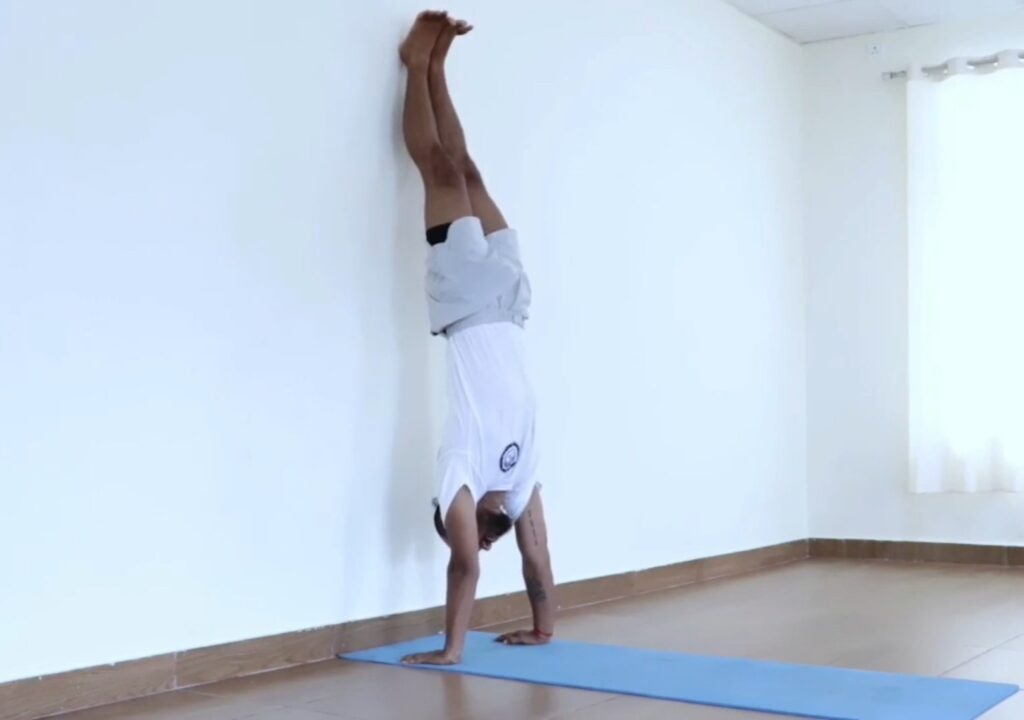
Handstand Pose – how to do handstand for beginners | Handstand benefits
Adho- mukha- vrkshasanaadho (adho = downward; mukha = face)
vrksa = tree
Handstand pose is the position which help your arms to understand about body balance and give strength & stability to your arms and core. The challenge of the handstand pose lies in maintaining alignment in your spine and legs, here gravity works against you. We need to work on the spine to not get any tilt and twist, hip should not fall back towards the spine. It is also an effective strengthener for arms, legs and shoulders.
How to Perform Handstand
We need to give an idea to get a solid foundation for handstand. We can practice a few poses before handstand:
- 1. Adho mukha veerasana
- 2. Adho mukha svanasana
- 3. High plank
Step 1:
Perform Adho Mukha Svanasana (downward-Facing dog pose) placing your palms on the ground one palm away from a wall, hands shoulder-width. If your shoulders are tight, turn your index fingers out slightly; otherwise, arrange them parallel to each other. To ready yourself for and secure yourself in this inversion, firm your shoulder blades against your back torso and pull them toward your tailbone. Then rotate your upper arms outward, to keep the shoulder blades broad, and hug your outer arms inward. Finally spread your palms and press the bases of the index fingers firmly against the floor.
Step 2:
Now bend one knee and step the foot in, closer to the wall (we’ll say it’s the left leg), but keep the other (i.e. right) leg active by extending through the heel. Then take a few practice hops before you try to launch yourself upside down. Sweep your right leg through a wide arc toward the wall and kick your left foot off the floor, immediately pushing through the heel to straighten the left knee. As both legs come off the ground, engage your deep core abdominal muscles to help lift your hips over your shoulders. Hop up and down like this several times, each time pushing off the floor a little higher.
How Can I Overcome My Fear of Handstand?
Step 3:
Hopping up and down like this may be all you can manage for now. Regularly practice strengthening poses, like Adho Mukha Svanasana and Plank Pose. Eventually, you’ll be able to kick all the way into the pose. At first, your heels may crash into the wall, but again with more practice, you’ll be able to swing your heels up lightly to the wall.
Step 4:
If your armpits and groins are tight, your lower back may be deeply arched. To lengthen this area, draw your front ribs into your torso, reach your tailbone toward your heels, and slide your heels higher up the wall. Squeeze the outer legs together and roll the thighs in. Hang your head from a spot between your shoulder blades and gaze out into the center of the room.
Step 5:
To start stay in the pose for 10 to 15 seconds, breathing deeply. When you come down, be sure not to sink onto the shoulders. Keep your shoulder blades lifted and broad, and take one foot down at a time, each time with an exhalation. Come back into adho mukha svanasana for 30 seconds. We tend to kick up with the same leg all the time: be sure to alternate your kicking leg, one time right, next time left.
Benefits
- Strengthens the shoulders, arms, and wrists
- Stretches the belly
- Improves sense of balance
- Calms the brain and helps relieve stress and mild depression
Variations
You can vary this pose by placing your hands in different positions. For example, you can narrow your hands inside shoulder width, which decreases your base of support and so develops your sense of balance. Or you can turn your hands outward, which will teach you how to externally rotate the upper arm.
Precaution:
- Avoid if you have wrist, shoulder, or lower back injury
- High blood pressure
- The third trimester of pregnancy
- During menstruation
Modification and Props:
People who struggle with arm strength can practice downward facing dog by using a strap around the arm. Place the strap in the area right above the elbow and below the tricep.
You can use a chair while doing a downward-facing dog by placing the chair right underneath the feet. Try to shift your body weight onto the hands to build strength in your triceps, deltoids, latissimus dorsi, and the serratus anterior.
Join Yoga Teacher Training in Rishikesh Yoga Teacher Training in Bali